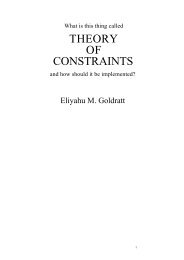- Page 2 and 3:
The Making of a German Constitution
- Page 4:
The Making of a German Constitution
- Page 58 and 59:
Prelude to Modern Germany • 43for
- Page 60 and 61:
Prelude to Modern Germany • 45Nev
- Page 62 and 63:
Prelude to Modern Germany • 47pre
- Page 64 and 65:
Prelude to Modern Germany • 49the
- Page 66 and 67:
Prelude to Modern Germany • 51The
- Page 68 and 69:
Prelude to Modern Germany • 5326.
- Page 70 and 71:
Prelude to Modern Germany • 5585.
- Page 72 and 73:
-2-Toward a German NationFriedrich
- Page 74 and 75:
Toward a German Nation • 59legisl
- Page 76 and 77:
Toward a German Nation • 61Savign
- Page 78 and 79:
Toward a German Nation • 63to the
- Page 80 and 81:
Toward a German Nation • 65govern
- Page 82 and 83:
Toward a German Nation • 67Legisl
- Page 84 and 85:
Toward a German Nation • 69Lübec
- Page 86 and 87:
Toward a German Nation • 71which
- Page 88 and 89:
Toward a German Nation • 73earlie
- Page 90 and 91:
Toward a German Nation • 75Refini
- Page 92 and 93:
Toward a German Nation • 77transf
- Page 94 and 95:
Toward a German Nation • 79diffid
- Page 96 and 97:
Toward a German Nation • 81respon
- Page 98 and 99:
Toward a German Nation • 83Writin
- Page 100 and 101:
Toward a German Nation • 85unders
- Page 102 and 103:
Toward a German Nation • 87The go
- Page 104 and 105:
Toward a German Nation • 89The va
- Page 106 and 107:
Toward a German Nation • 91was al
- Page 108 and 109:
Toward a German Nation • 9338. Bl
- Page 110 and 111:
Toward a German Nation • 95101. F
- Page 112 and 113:
Toward a German Nation • 97167. F
- Page 114 and 115:
-3-Images of the GemeinwesenThe Ger
- Page 116 and 117:
Images of the Gemeinwesen • 101th
- Page 118 and 119:
Images of the Gemeinwesen • 103of
- Page 120 and 121:
Images of the Gemeinwesen • 105re
- Page 122 and 123:
Images of the Gemeinwesen • 107de
- Page 124 and 125:
Images of the Gemeinwesen • 109ge
- Page 126 and 127:
Images of the Gemeinwesen • 111pu
- Page 128 and 129:
Images of the Gemeinwesen • 113Nu
- Page 130 and 131:
Images of the Gemeinwesen • 115Eu
- Page 132 and 133: Images of the Gemeinwesen • 117Wh
- Page 134 and 135: Images of the Gemeinwesen • 119co
- Page 136 and 137: Images of the Gemeinwesen • 121co
- Page 138 and 139: Images of the Gemeinwesen • 123th
- Page 140 and 141: Images of the Gemeinwesen • 12525
- Page 142 and 143: Images of the Gemeinwesen • 12791
- Page 144 and 145: Images of the Gemeinwesen • 12917
- Page 146 and 147: -4-Undermining AbsolutismThe Path o
- Page 148 and 149: Undermining Absolutism • 133sat o
- Page 150 and 151: Undermining Absolutism • 135for a
- Page 152 and 153: Undermining Absolutism • 137the p
- Page 154 and 155: Undermining Absolutism • 139in mi
- Page 156 and 157: Undermining Absolutism • 141jury
- Page 158 and 159: Undermining Absolutism • 143Reich
- Page 160 and 161: Undermining Absolutism • 145journ
- Page 162 and 163: Undermining Absolutism • 147found
- Page 164 and 165: Undermining Absolutism • 149In th
- Page 166 and 167: Undermining Absolutism • 151The B
- Page 168 and 169: Undermining Absolutism • 153subse
- Page 170 and 171: Undermining Absolutism • 1551840.
- Page 172 and 173: Undermining Absolutism • 157the H
- Page 174 and 175: Undermining Absolutism • 159Compr
- Page 176 and 177: Undermining Absolutism • 16137. M
- Page 178 and 179: Undermining Absolutism • 16396. J
- Page 180 and 181: Undermining Absolutism • 165140.
- Page 184 and 185: A Century of Promise • 169in Germ
- Page 186 and 187: A Century of Promise • 171of work
- Page 188 and 189: A Century of Promise • 173scholar
- Page 190 and 191: A Century of Promise • 175was ess
- Page 192 and 193: A Century of Promise • 177marital
- Page 194 and 195: A Century of Promise • 179communi
- Page 196 and 197: A Century of Promise • 181Court w
- Page 198 and 199: A Century of Promise • 183be unde
- Page 200 and 201: A Century of Promise • 1851900. I
- Page 202 and 203: A Century of Promise • 18755. For
- Page 204 and 205: -6-Last BastionThe Bürgerliches Ge
- Page 206 and 207: Last Bastion • 191prominent liber
- Page 208 and 209: Last Bastion • 193Osnabrück, her
- Page 210 and 211: Last Bastion • 195be equal, as th
- Page 212 and 213: Last Bastion • 197The Eulenburg-M
- Page 214 and 215: Last Bastion • 199and, when Wilhe
- Page 216 and 217: Last Bastion • 201magnified onto
- Page 218 and 219: Last Bastion • 203but equal to ot
- Page 220 and 221: Last Bastion • 205the wall. 103 A
- Page 222 and 223: Last Bastion • 207of tender ages
- Page 224 and 225: Last Bastion • 2091368) and inher
- Page 226 and 227: Last Bastion • 211for legal unity
- Page 228 and 229: Last Bastion • 213Politiker nach
- Page 230 and 231: Last Bastion • 21559. Ibid.60. Wi
- Page 232 and 233:
Last Bastion • 217110. Ibid., p.
- Page 234 and 235:
-7-Discontent in the Bürgerliche S
- Page 236 and 237:
Discontent in the Bürgerliche Soci
- Page 238 and 239:
Discontent in the Bürgerliche Soci
- Page 240 and 241:
Discontent in the Bürgerliche Soci
- Page 242 and 243:
Discontent in the Bürgerliche Soci
- Page 244 and 245:
Discontent in the Bürgerliche Soci
- Page 246 and 247:
Discontent in the Bürgerliche Soci
- Page 248 and 249:
Discontent in the Bürgerliche Soci
- Page 250 and 251:
Discontent in the Bürgerliche Soci
- Page 252 and 253:
Discontent in the Bürgerliche Soci
- Page 254 and 255:
Discontent in the Bürgerliche Soci
- Page 256 and 257:
Discontent in the Bürgerliche Soci
- Page 258 and 259:
Discontent in the Bürgerliche Soci
- Page 260 and 261:
Discontent in the Bürgerliche Soci
- Page 262 and 263:
Discontent in the Bürgerliche Soci
- Page 264 and 265:
Discontent in the Bürgerliche Soci
- Page 266 and 267:
-8-ConclusionThe German Idea of Rev
- Page 268 and 269:
Conclusion • 253revolution affect
- Page 270 and 271:
Conclusion • 255Savigny’s call
- Page 272 and 273:
Conclusion • 257violent movement,
- Page 274 and 275:
Conclusion • 259supremacy of the
- Page 276 and 277:
Conclusion • 2611354 granted the
- Page 278 and 279:
Conclusion • 263cannot be denied,
- Page 280 and 281:
Conclusion • 26532. Achim Kurz, D
- Page 282 and 283:
BibliographyAaslestad, K., ‘Old V
- Page 284 and 285:
Bibliography • 269Bachrach, D.,
- Page 286 and 287:
Bibliography • 271Bruns, C., ‘T
- Page 288 and 289:
Bibliography • 273Engels, F., The
- Page 290 and 291:
Bibliography • 275Grimm, D., ‘D
- Page 292 and 293:
Bibliography • 277Jenks, E., Law
- Page 294 and 295:
Bibliography • 279Lange, H., ‘F
- Page 296 and 297:
Bibliography • 281Nauert, C., Hum
- Page 298 and 299:
Bibliography • 283Quataert, J., R
- Page 300 and 301:
Bibliography • 285Schleiermacher,
- Page 302 and 303:
Bibliography • 287Thibaut, A., Ü
- Page 304 and 305:
IndexAlbrecht, Wilhelm, 141, 203All
- Page 306 and 307:
Index • 291economic consideration
- Page 308 and 309:
Index • 293law journals, founding
- Page 310 and 311:
Index • 295Schroeder, Richard, 16




